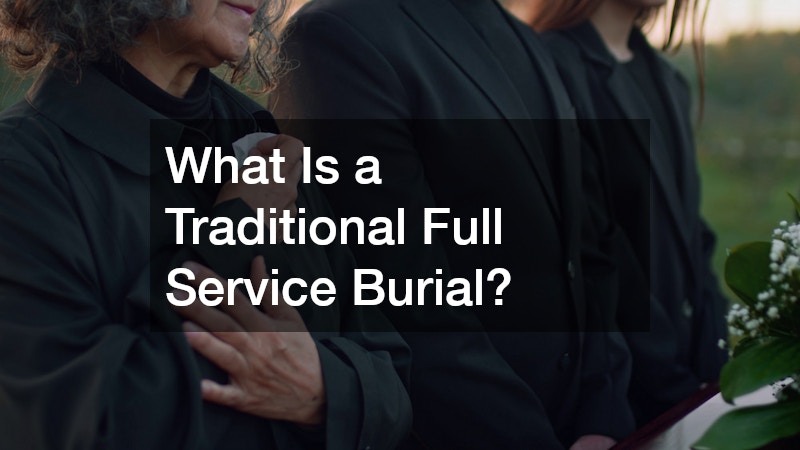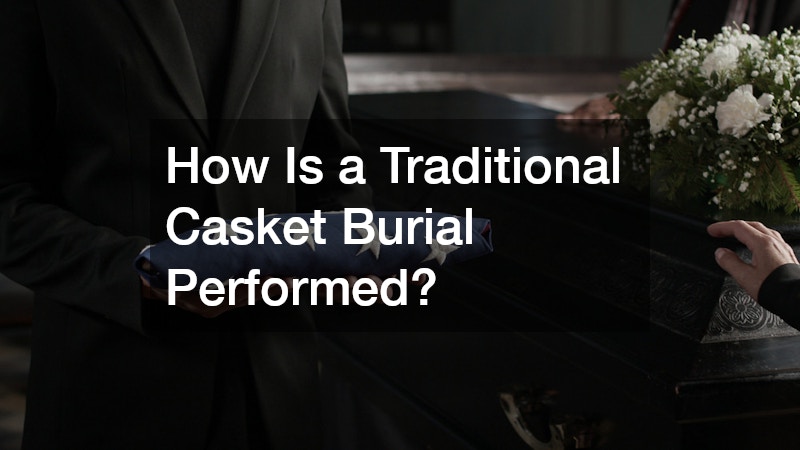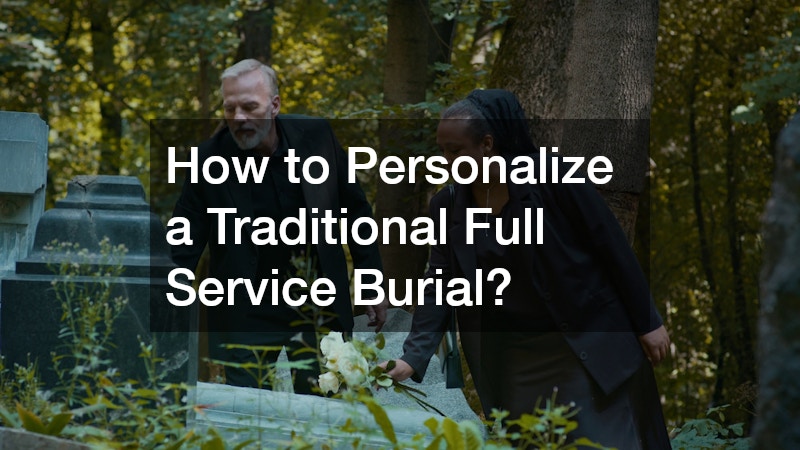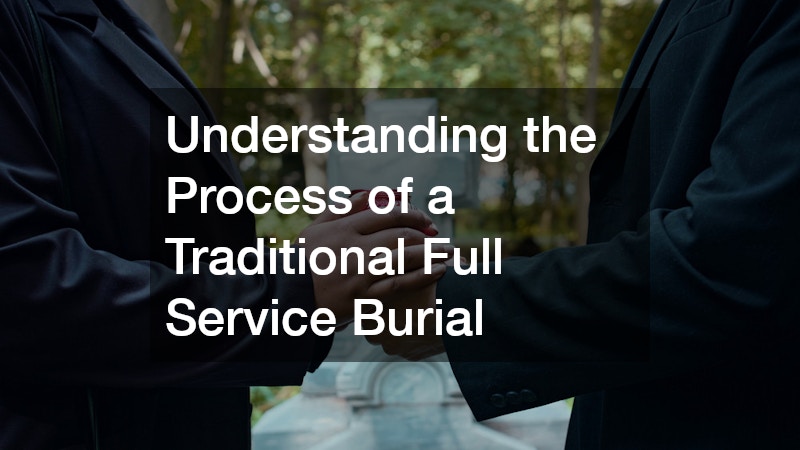
Losing a loved one is an emotionally challenging experience, and planning a farewell that honors their life can be overwhelming. A traditional full-service burial provides a structured and comprehensive approach to saying goodbye, combining ritual, ceremony, and support for grieving families. This article explores the key elements, considerations, and steps involved in arranging a traditional full service burial. By understanding the process, families can make informed decisions that reflect the wishes of the deceased while providing comfort to those left behind.
What Is a Traditional Full Service Burial?

Definition and Overview
A traditional full service burial is a type of funeral that encompasses the full range of services typically associated with honoring a deceased individual. Unlike simpler or direct burials, this option involves a formal funeral service, often including a viewing or wake, a casket ceremony, transportation to a cemetery, and a graveside service.
Historical Context and Evolution
The practice of traditional burials dates back centuries, rooted in both religious and cultural traditions. Over time, the rituals surrounding burial have evolved, but the emphasis on ceremony, respect, and communal mourning remains central.
Main Components of the Funeral Service
A traditional full service burial typically includes several interconnected elements. These often comprise the preparation of the body, viewing or wake, formal funeral ceremony, transportation to the burial site, and the graveside service itself. Cremation services differ from this model but can sometimes be incorporated as an alternative for certain family members or in blended ceremonies.
Typical Duration and Structure
The overall process of a traditional full service burial can span several days, from initial arrangements with the funeral home to the interment. The funeral service itself often lasts one to two hours, with additional time allocated for visitations and graveside gatherings. Scheduling is coordinated with the funeral service provider, cemetery officials, and family members to ensure all aspects run smoothly.
Cultural and Religious Influences
Cultural and religious traditions heavily influence the structure and customs of a traditional full service burial. From prayers and rituals to the display of memorials and readings, each ceremony can be tailored to reflect the beliefs and heritage of the deceased and their family.
How to Choose a Funeral Home for a Traditional Burial?
Factors to Consider
Selecting a funeral home is one of the most important steps in planning a traditional full service burial. Families should consider location, reputation, the range of services offered, and experience with specific cultural or religious customs. The chosen provider should offer guidance on funeral planning while accommodating personal preferences and logistical requirements.
Questions to Ask the Funeral Director
When meeting with a funeral director, it is helpful to ask about the types of funeral service packages available, casket options, coordination with limo services for transportation, and arrangements for graveside ceremonies. Inquiring about the process for obtaining insurance agency support or coordinating payment plans can also provide clarity during an emotionally challenging time.
Comparing Costs and Services
Funeral homes offer a variety of service packages, and costs can vary significantly. Comparing services and pricing ensures families select a package that meets their needs without exceeding their budget. Some providers offer bundled packages that include casket selection, headstones, transportation, and ceremony planning, which can simplify decision-making.
Checking Credentials and Licenses
Verifying that a funeral home is properly licensed and accredited is essential. This ensures compliance with state and local regulations and provides peace of mind that professional standards are met. Families may also consult consumer protection agencies or online reviews for additional assurance.
Reading Reviews and Testimonials
Reading reviews and testimonials from previous clients offers insight into a funeral home’s service quality and reliability. Families may gain valuable perspective on staff professionalism, the care taken with memorials and ceremonies, and the support provided to grieving relatives.
What Happens During the Viewing or Wake?

Purpose and Significance
The viewing or wake is a central element of a traditional full service burial, providing a structured opportunity for friends and family to pay respects to the deceased. This gathering allows loved ones to offer condolences, share memories, and begin the grieving process in a supportive environment.
Setting and Atmosphere
Viewings are typically held at the funeral home in a quiet, contemplative setting. The atmosphere is designed to encourage reflection, comfort, and connection among attendees. Floral arrangements, candles, and headstones on display can further personalize the space.
Role of the Family and Friends
During the viewing, family members may greet guests, offer guidance on seating, and participate in ceremonial activities such as lighting candles or sharing readings. Friends and extended family often play a supportive role, helping to maintain a calm and respectful environment.
Common Customs and Rituals
Customs at viewings vary widely depending on cultural or religious traditions. Some families incorporate prayers, hymns, or symbolic gestures to honor the deceased. Attendees may also observe moments of silence, light candles, or leave memorials at the viewing site.
Dress Code and Etiquette
Guests are typically expected to wear formal or somber attire during the viewing. Respectful behaviour, including refraining from loud conversation and adhering to cultural or religious customs, ensures the occasion maintains its dignity and solemnity.
What Are the Key Elements of the Funeral Ceremony?
Order of Service
A traditional full service burial often follows a structured order of service. This may include an opening prayer, readings, musical selections, eulogies, and final remarks from the officiant. The sequence ensures that the ceremony flows smoothly and provides space for reflection and emotional support.
Role of the Officiant
The officiant, often a religious leader or trained celebrant, guides the ceremony and ensures all planned rituals are observed. They may offer comfort through readings, prayers, or personal reflections that honor the life of the deceased.
Popular Readings and Music
Readings and music are integral to a meaningful funeral service. Families may choose passages from sacred texts, poetry, or personal letters. Musical selections can range from traditional hymns to contemporary pieces that hold significance for the deceased.
Eulogies and Tributes
Eulogies provide an opportunity to reflect on the deceased’s life and contributions. Family members and close friends may share stories, personal achievements, and lessons learned, creating a memorable tribute for all in attendance.
Incorporating Personal Touches
Personalization is a hallmark of a traditional full service burial. Families may include photographs, favorite objects, or symbolic items that reflect the life and interests of the deceased. These touches help create a ceremony that feels intimate and meaningful.
How Is a Traditional Casket Burial Performed?

Preparation of the Body
Prior to the funeral service, the body is prepared according to family wishes and cultural or religious traditions. This may involve embalming, dressing, and cosmetic preparation to ensure the deceased is presented respectfully during the viewing and ceremony.
Casket Selection and Options
Choosing a casket is a significant decision for families arranging a traditional full service burial. Options vary widely in material, design, and price. Funeral homes provide guidance on selecting a casket that aligns with the family’s budget and preferences.
Transportation to the Cemetery
Transportation logistics are coordinated with the funeral home, often including limo services for family members and vehicles for the deceased. Local movers may be consulted if large or heavy items, such as headstones or floral arrangements, need to be transported to the cemetery.
Graveside Service Details
The graveside service includes final prayers, readings, and sometimes musical tributes. Family members may participate in lowering the casket, placing memorials, or performing other symbolic gestures.
Lowering of the Casket
The lowering of the casket marks the final stage of the burial process. Attendees often observe a moment of silence, reflection, or prayer as the casket is interred, signifying closure and the respectful conclusion of the ceremony.
What Are the Legal Requirements for a Full Service Burial?
Obtaining a Burial Permit
Securing the necessary permits is an essential legal requirement. Funeral homes typically assist families in obtaining these documents, ensuring compliance with local regulations and cemetery policies.
Cemetery Rules and Regulations
Each cemetery has specific rules regarding plot selection, grave markers, and headstones. Understanding these regulations ahead of time helps families make informed decisions and avoid last-minute complications.
Understanding Burial Contracts
Burial contracts outline the services provided, costs, and responsibilities of both the funeral home and the family. Reviewing these agreements carefully ensures that expectations are clear and legally documented.
Environmental Regulations
Environmental considerations, such as restrictions on embalming chemicals or casket materials, may impact planning. Families should consult with funeral directors and cemeteries to ensure adherence to all relevant laws.
Documentation Needed
In addition to permits, families may need death certificates, identification, and insurance agency paperwork to facilitate payment, insurance claims, or estate matters.
How to Personalize a Traditional Full Service Burial?

Personalizing Funeral Programs
Funeral programs can be customized with photographs, biographies, and favorite quotations. These programs serve as both a guide for attendees and a keepsake for family members.
Choosing Personal Items for Display
Items that reflect the deceased’s hobbies, achievements, or passions may be displayed during the viewing or ceremony. This can include awards, musical instruments, or personal mementos that create a lasting impression.
Incorporating Cultural Traditions
Families may include traditional prayers, rituals, or Senior Living practices that honor the deceased’s heritage. These elements can add depth and authenticity to the ceremony.
Special Arrangements for Guests
Considerations for guests may include accessible seating, provision of Senior Care for elderly attendees, or transportation via limo services. Thoughtful planning ensures that all loved ones can participate comfortably.
Unique Ways to Honor the Deceased
Families may choose to plant memorial gardens, install headstones, or create charitable contributions in the deceased’s name. These personalized touches extend the legacy beyond the funeral service itself.
What Does a Traditional Full Service Burial Cost?
Breakdown of Costs
The cost of a traditional full service burial includes funeral home fees, casket selection, transportation, cemetery charges, and additional services such as floral arrangements and memorials. Understanding the full scope of expenses allows families to budget appropriately.
Finding Affordable Options
Families can explore options to reduce costs without compromising quality. This may include selecting less expensive caskets, limiting the number of services, or consulting multiple funeral homes for competitive pricing.
Funeral Packages and Plans
Many funeral homes offer packages that combine essential services, funeral service planning, and burial arrangements. Pre-planning these packages can simplify logistics and provide financial predictability.
Understanding Insurance Coverage
Life insurance policies and funeral insurance may cover some or all costs associated with a traditional full service burial. Consulting an insurance agency can clarify coverage and ensure that financial resources are available when needed.
Comparing Burial vs. Cremation Costs
While cremation services are sometimes less expensive, a traditional full service burial provides the ceremonial depth and structure that many families value. Comparing costs and services allows families to make choices aligned with their priorities.
How to Arrange Funeral Transportation?
Types of Vehicles Used
Funeral transportation may include hearses, limo services, or other vehicles to transport family and friends. Local movers may assist with larger items such as headstones or floral arrangements, ensuring safe and efficient delivery to the cemetery.
Coordinating With the Funeral Home
Effective coordination with the funeral home ensures that all transportation needs are met. Timely communication helps avoid delays and ensures that the ceremony proceeds smoothly.
Options for Guests and Family
Transportation options for guests can include shuttle services, carpooling, or rental moving services. Ensuring accessibility for elderly or mobility-impaired attendees is an important consideration.
Scheduling Considerations
Timing is critical in funeral transportation. Coordination with the cemetery, officiant, and family members ensures that the service begins on schedule and all participants are accounted for.
Handling Unexpected Delays
Funeral directors and transportation providers are equipped to manage unforeseen delays, such as traffic or weather disruptions. Having contingency plans ensures that the ceremony remains dignified and uninterrupted.
What Are the Roles of Family and Friends?
Participation in the Ceremony
Family and friends often play active roles in a traditional full service burial, including greeting guests, participating in readings, or assisting with ceremonial duties.
Support and Assistance Roles
Loved ones provide emotional support, assist with logistics, and help manage the flow of the service. This can include arranging memorials, directing guests, or providing Senior Care support for elderly attendees.
Selecting Pallbearers
Choosing pallbearers is an important responsibility for close family members or friends. These individuals carry the casket during the graveside service, symbolizing honor and respect.
Delivering Eulogies and Readings
Eulogies and readings provide a personal perspective on the deceased’s life. Family members may share cherished memories, values, and achievements, contributing to a heartfelt farewell.
Guiding Younger Family Members
Younger attendees may require guidance on proper etiquette, participation in rituals, or emotional support during the service. Involving them appropriately helps preserve family traditions and ensures continuity.
Understanding the process of a traditional full service burial is essential for families navigating the complexities of end-of-life planning. From choosing a funeral home and preparing the body to arranging limo services, coordinating moving services, and selecting headstones or memorials, each stage plays a vital role in creating a dignified farewell. Incorporating cultural, personal, and legal considerations ensures that the ceremony reflects the wishes of the deceased while providing support and comfort to grieving loved ones. With careful planning, attention to detail, and the assistance of professionals such as insurance agencies, funeral directors, and local movers, families can honor their loved ones through a meaningful and memorable traditional full service burial.



